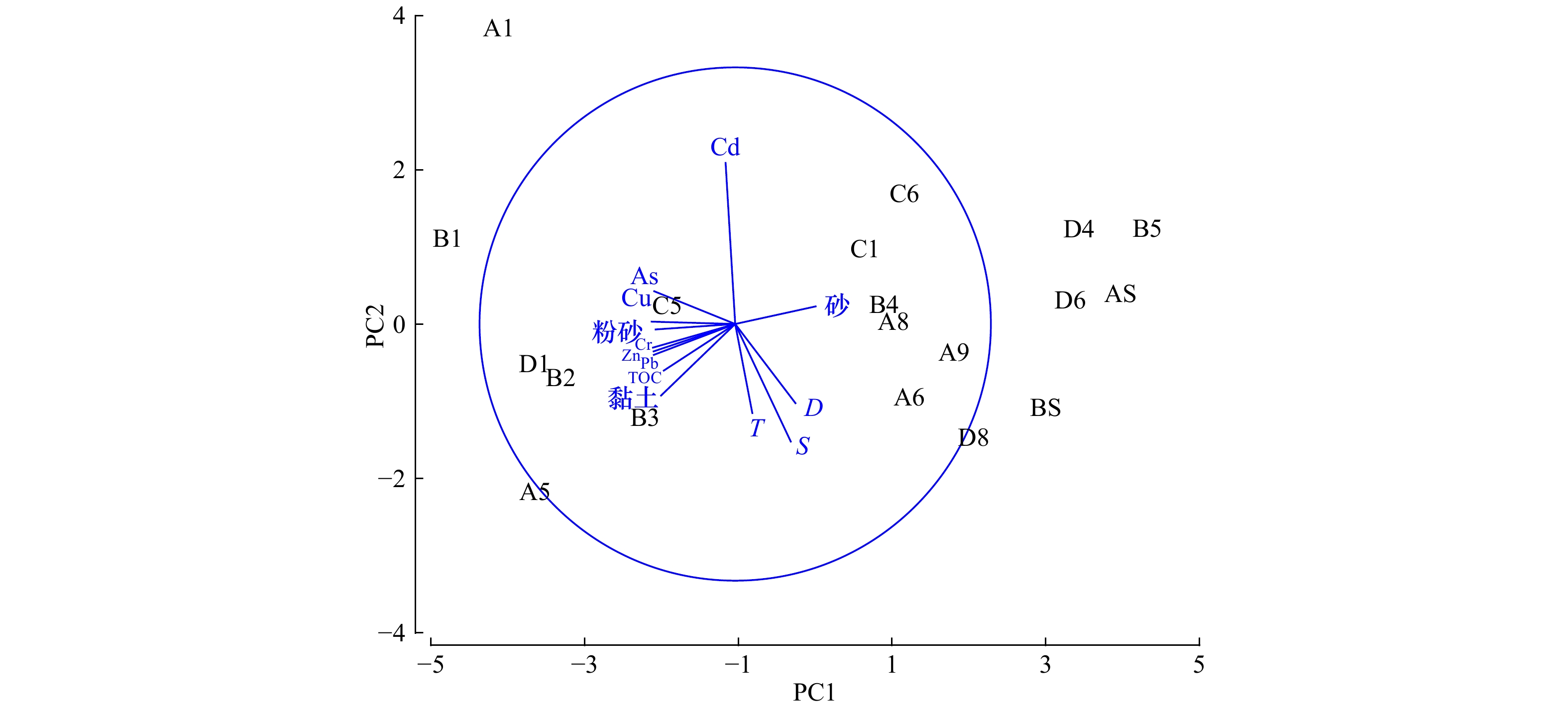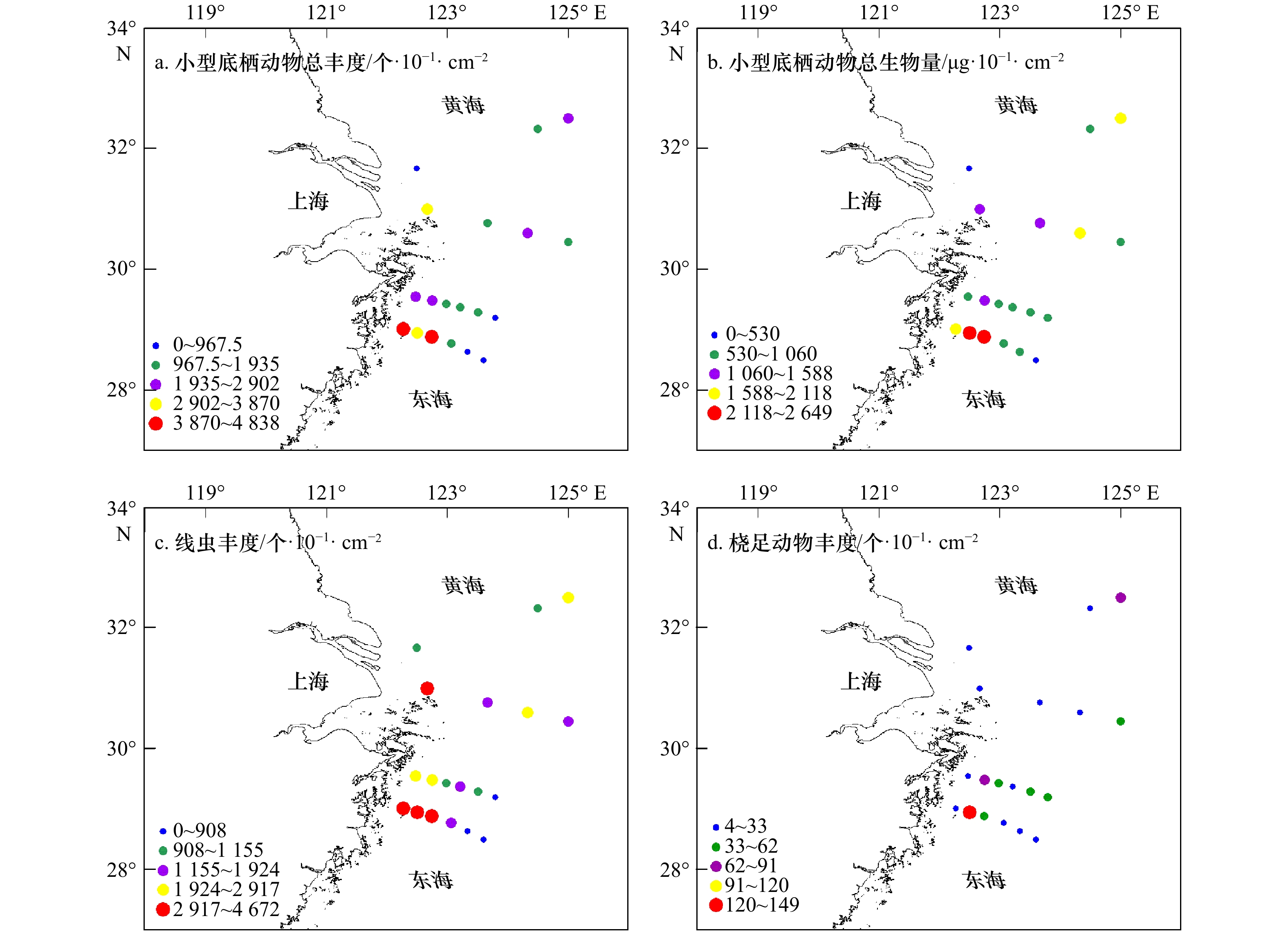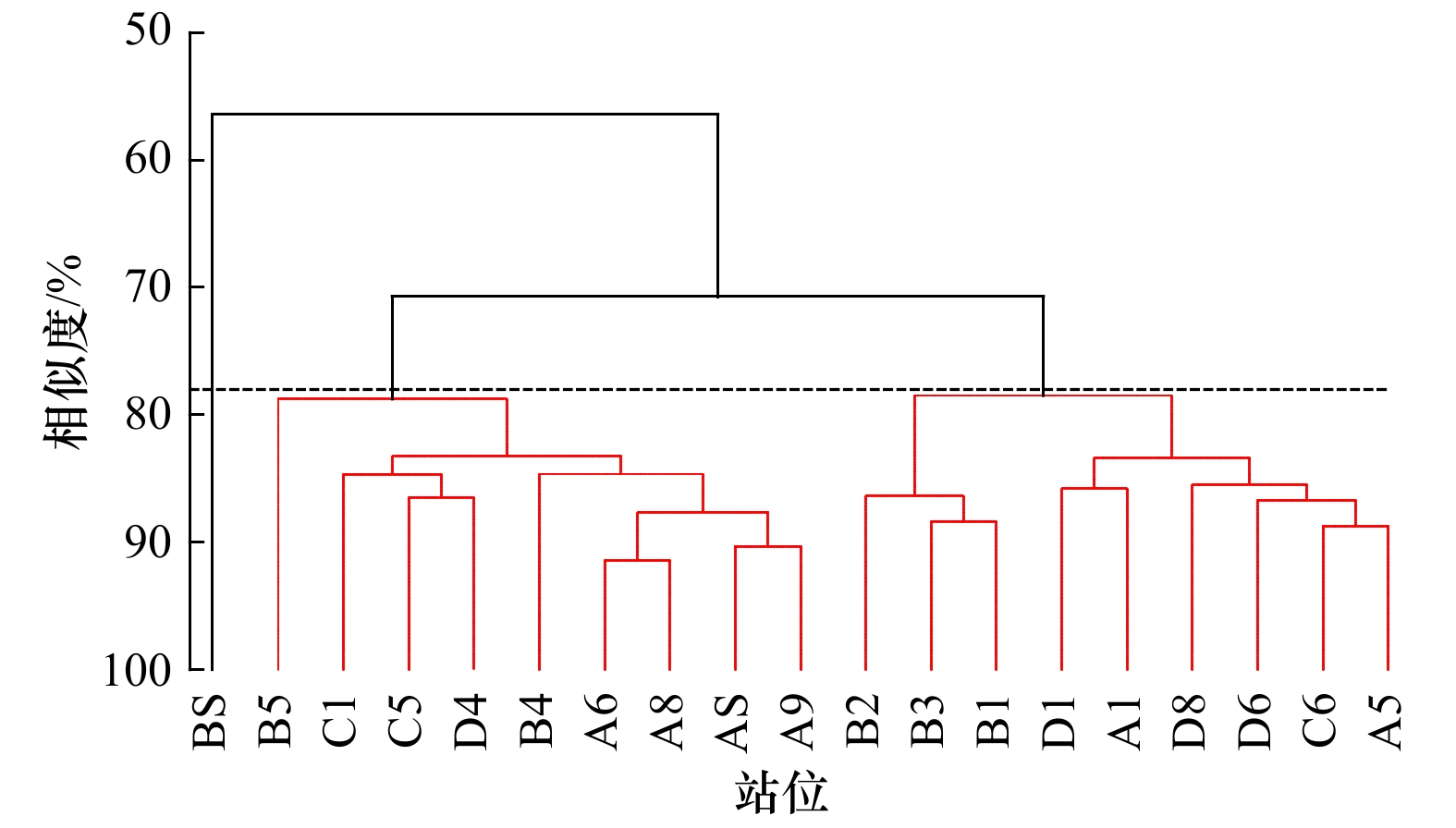The communities of meiofauna in the northern East China Sea and their responses to runoff and the intrusion of Kuroshio Current
-
摘要: 为探究小型底栖动物群落在东海北部及其临近海域的分布规律,及其对环境因子的响应,于2016年9月和12月,对研究海域共计20个站位的小型底栖动物和环境因子进行了取样调查。调查结果显示,研究海域内共鉴定出小型底栖动物类群16个,其中海洋线虫为绝对优势类群,其他优势类群主要包括桡足类、动吻类和多毛类。9月航次小型底栖动物平均丰度为(1 758±759)个/(10 cm2),线虫占95.6%;平均生物量为(1 216.4±464.7) μg/(10 cm2)(干重),线虫占55.26%。12月航次平均丰度为(2 011±1 471)个/(10 cm2),线虫占95.6%;平均生物量为(1 143.0±755.0)μg/(10 cm2)(干重),线虫占67.28%。聚类分析结果显示,小型底栖动物群落主要可以划分为近岸和外海两个组,其中近岸组小型底栖动物丰度显著高于外海站位。但在各断面分布上,绝大多数站位小型底栖动物丰度最高值均出现在60 m等深线附近,并且该水深处站位的温度和盐度数值均表现出黑潮水的特征。黑潮近岸分支对东海陆架入侵是导致小型底栖动物分布差异的重要原因,小型底栖动物在60 m等深线附近具有的高丰度值可作为其对黑潮入侵的响应。推测,黑潮入侵所导致的水体初级生产力增加以及黑潮水所携带的溶氧可能是导致该深度处小型底栖动物丰度增加的主要原因。Abstract: Meiofaunal communities and the relationships with environmental variables in the northern East China Sea and its adjacent area were studied in the present paper based on the material collected from 20 sites in September and December, 2016. About 16 meiofaunal groups were identified with nematodes being the most dominant group, followed by copepods, kinorhynchs and polychaetas. The average abundances of meiofauna were (1 758±759) ind./(10 cm2), and (2 011±1 471) ind./(10 cm2) in September and December, respectively. The average biomasses of meiofauna were (1 216.4±464.7) μg/(10 cm2) and (1 143.0±755.0) μg/(10 cm2) in September and December, respectively. Results of CLUSTER analysis show that meiofaunal communities can be divided into two main groups, one was the offshore group, composed of stations in the offshore area, another group was the coastal group, composed of stations in the coastal area. However, the highest value of abundance always occurred in the depth about 60 m isobath where the salinity and temperature showed the characters of Kuroshio Current implying the intrusion of Kuroshio. We suggest that the intrusion of Kuroshio Current is the main cause of the increase of meiofaunal abundance, which can be treated as a response of meiofauna to the intrusion of Kuroshio, around the 60 m isobath. The high abundance of meiofauna may be explained by dissolved oxygen brought by the Kuroshio waters, and high primary production of water column benefitted from the supplying of phosphorus of the Kuroshio waters.
-
Key words:
- meiofauna /
- ecology /
- bio-indicators /
- Changjiang River Estuary /
- Kuroshio Current
-
表 1 各站位水深、底层和表层水温和盐度
Tab. 1 Depth, temperature and salinity of the surface and bottom water of each site
2016年9月 2016年12月 站位 D/m TB/℃ SB TS/℃ SS 站位 D/m TB/℃ SB TS/℃ SS C1 28 24.3 32.2 25.3 31.5 B1 30 17.2 31.5 15.7 28.8 C3 42 24.7 32.5 25.7 32.5 B2 52 18.9 33.7 17.0 31.9 C5 44 22.0 31.1 25.4 29.7 B3 61 19.4 34.2 19.7 33.9 C6 58 14.2 32.2 25.4 29.7 B4 66 19.5 34.3 21.0 33.8 D1 21 23.5 31.5 26.2 17.5 B5 68 20.2 34.1 21.0 33.9 D4 54 19.7 34.5 25.9 29.4 BS 79 19.9 34.3 20.6 34.1 D6 59 21.4 34.4 27.4 31.7 A1 25 16.2 28.8 15.7 26.6 D8 66 23.2 34.3 27.6 33.1 A5 54 20.0 33.9 20.0 33.9 A6 61 20.3 34.3 20.3 34.3 A8 64 20.3 34.3 20.3 34.3 A9 71 20.2 34.3 20.2 34.3 AS 68 20.3 34.3 20.5 34.3 注:D代表水深;TB代表底层水温;SB代表底层盐度;TS代表表层水温;SS代表表层盐度。 表 2 沉积物有机质和部分重金属含量
Tab. 2 Organic matter and heavy metal contents of the sediment
站位 TOC/% Pb Cr Cu Zn Cd As 站位 TOC/% Pb Cr Cu Zn Cd As D1 0.56 32.3 91.4 32.1 103.2 0.2 11.6 A8 0.54 24.8 78.2 17.3 83.0 2.1 5.2 D4 0.27 19.7 61.3 10.1 56.4 2.1 4.3 A9 0.39 25.0 76.9 16.9 81.8 1.2 4.3 D6 0.34 19.1 63.1 10.1 57.1 1.4 3.9 AS 0.40 17.3 57.6 10.4 57.2 1.3 3.6 D8 0.36 22.6 67.7 14.2 68.7 0 5.0 B1 0.69 36.4 95.8 39.4 115.1 2.0 12.7 C1 0.37 18.7 66.4 17.2 65.6 1.6 7.2 B2 0.70 34.1 92.1 35.9 108.5 1.5 9.3 C5 0.42 27.6 89.7 21.1 83.5 1.5 8.6 B3 0.70 30.9 90.7 25.4 104.7 1.5 7.0 C6 0.40 24.3 72.0 17.4 70.9 1.6 5.7 B4 0.57 24.8 77.1 17.2 82.7 2.4 5.4 A1 0.55 31.0 90.3 35.6 103.7 3.8 12.0 B5 0.32 16.3 56.2 8.9 53.2 2.1 4.9 A5 0.79 35.6 95.6 35.5 111.8 0 10.4 BS 0.29 19.5 59.8 10.3 59.0 0 2.9 A6 0.45 24.7 75.9 17.6 81.5 0.2 6.0 注:重金属含量单位为mg/kg。 表 3 研究海域环境因子间相关性
Tab. 3 Correlation between environmental variables of the study area
TOC Pb Cr Cu Zn Cd As D T S 黏土 粉砂 砂 Pb 0.89** Cr 0.86** 0.97** Cu 0.86** 0.96** 0.93** Zn 0.92** 0.98** 0.97** 0.96** Cd 0.05 0.00 0.07 0.12 0.06 As 0.72** 0.85** 0.85** 0.94** 0.85** 0.18 D −0.33 −0.50* −0.55* −0.66** −0.51* −0.28 −0.84** T −0.24 −0.28 −0.20 −0.27 −0.25 −0.48* −0.16 −0.06 S −0.21 −0.44 −0.50* −0.59** −0.44 −0.44 −0.75** 0.83** 0.25 黏土 0.77** 0.86** 0.89** 0.78** 0.84** −0.20 0.70** −0.39 −0.03 −0.36 粉砂 0.65** 0.80** 0.84** 0.87** 0.81** 0.03 0.86** −0.73** 0.00 −0.67** 0.85** 砂 −0.69** −0.84** −0.87** −0.87** −0.84** 0.01 −0.85** 0.69** 0.01 0.63** −0.89** −0.99** Mz −0.65** −0.80** −0.83** −0.82** −0.80** 0.08 −0.79** 0.64** −0.07 0.55* −0.88** −0.98** 0.99** 注:*表示在0.05水平(双侧)上显著相关;**表示在0.01水平(双侧)上显著相关;TOC代表有机质含量;D代表水深;T代表温度;S代表盐度。 表 4 小型底栖动物丰度和环境因子相关性
Tab. 4 Relative coefficient between meiofaunal abundance and environmental variables
总丰度 线虫类 桡足类 动吻类 多毛类 双壳类 介形类 TOC 0.418 0.408 0.414 0.674** −0.131 −0.270 −0.325 Pb 0.510* 0.504* 0.340 0.689** −0.100 −0.238 −0.175 Cr 0.476* 0.473* 0.244 0.589** −0.074 −0.257 −0.161 Cu 0.534* 0.532* 0.278 0.667** −0.239 −0.283 −0.206 Zn 0.500* 0.498* 0.280 0.638** −0.149 −0.292 −0.265 Cd −0.094 −0.075 −0.414 −0.321 −0.266 −0.138 0.239 As 0.537* 0.543* 0.127 0.541* −0.265 −0.302 −0.142 深度 −0.378 −0.396 0.220 −0.202 0.290 0.228 −0.046 温度 −0.233 −0.224 −0.278 −0.261 −0.163 −0.395 −0.040 盐度 −0.337 −0.355 0.197 −0.065 0.212 0.030 −0.005 黏土 0.325 0.315 0.338 0.541* −0.020 −0.191 −0.213 粉砂 0.366 0.369 0.096 0.452 −0.270 −0.344 −0.121 砂 −0.367 −0.367 −0.143 −0.479* 0.230 0.324 0.141 注:*表示在0.05水平(双侧)上显著相关;**表示在0.01水平(双侧)上显著相关。 表 5 与同海域其他研究比较
Tab. 5 Comparison with other studies in the same area
平均丰度/
个·10−1 cm−2最高丰度/
个·10−1 cm−2最高丰度
海域平均生物量/μg·10−1 cm−2 线虫丰度
比/%线虫生物
量比/%其他优势
类群采样深度
/cm网筛孔径
/μm采样时间 参考文献 1 758±759 2 970 31.0°N,122.6°E 1 216±464 95.6 55.3 桡足、动吻 8 31 2016年9月 本研究 2 011±1471 4 837 28.8°N,122.7°E 1 143±755 95.6 67.3 桡足、动吻 8 31 2016年12月 本研究 654±441 1 626 27.8°N,122.0°E 807±517 87.0 28.0 桡足、多毛 10 50 2000年10月 张志南等[51] 342±252 / / 285±173 91.0 44.0 桡足、多毛 10 50 2001年4月 张志南等[51] 1 971±583 5 500 31.0°N,122.6°E 1 393±516 91.0 51.0 桡足、多毛、动吻、双壳 8 31 2003年6月 华尔等[20] 2 220±478 3 699 30.0°N,123.0°E 1 529±546 87.5 50.2 桡足、动吻 8 31 2003年6月 Hua等[47] 1 081±700 3 573 31.0°N,123.5°E 754±546 95.4 55.4 桡足、多毛、动吻、双壳 10 32 2007年4月 王小谷等[22] 1 140±675 2 515 30.5°N,123°E 1 058±627 85.7 36.9 桡足、动吻、多毛 8 31 2009年6月 吴秀琴[56] 1 081±700 2 739 31.0°N,122.5°E 600±374 94.4 68.1 涡虫、桡足、动吻、多毛 8 31 2009年11月 于婷婷和
徐奎栋[23]1 947±849 3 831 31.0°N,123.5°E / 90.0 37.0 桡足、多毛、动吻 8 31 2011年4月 孟昭翠[55] 1 203±191 1 501 32.0°N,124.0°E 723±171 94.1 62.1 桡足、动吻、多毛 8 31 2012年7月 史本泽等[24] -
[1] 李新正. 我国海洋大型底栖生物多样性研究及展望: 以黄海为例[J]. 生物多样性, 2011, 19(6): 676−684.Li Xinzheng. An overview of studies on marine macrobenthic biodiversity from Chinese waters: principally from the Yellow Sea[J]. Biodiversity Science, 2011, 19(6): 676−684. [2] Higgins R P, Thiel H. Introduction to the Study of Meiofauna[M]. Washington D. C. : Smithsonian Institute Press, 1988. [3] Giere O. Meiobenthology: the Microscopic Motile Fauna of Aquatic Sediments[M]. 2nd ed. Berlin, Heidelberg: Springer, 2009. [4] Nascimento F J A, Näslund J, Elmgren R. Meiofauna enhances organic matter mineralization in soft sediment ecosystems[J]. Limnology and Oceanography, 2012, 57(1): 338−346. doi: 10.4319/lo.2012.57.1.0338 [5] Bonaglia S, Nascimento F J A, Bartoli M, et al. Meiofauna increases bacterial denitrification in marine sediments[J]. Nature Communications, 2014, 5: 5133. doi: 10.1038/ncomms6133 [6] 苏纪兰. 中国近海的环流动力机制研究[J]. 海洋学报, 2001, 23(4): 1−16.Su Jilan. A review of circulation dynamics of the coastal oceans near China[J]. Haiyang Xuebao, 2001, 23(4): 1−16. [7] 白虹, 王凡. 台湾暖流水和长江冲淡水在32°N断面和PN断面上的分布及其变化[J]. 海洋科学集刊, 2010(50): 11−22.Bai Hong, Wang Fan. Distributions and variations of the Taiwan Warm Current Water and Changjiang Diluted Water along 32°N and PN sections[J]. Studia Marina Sinica, 2010(50): 11−22. [8] Yang Dezhou, Yin Baoshu, Liu Zhiliang, et al. Numerical study on the pattern and origins of Kuroshio branches in the bottom water of southern East China Sea in summer[J]. Journal of Geophysical Research: Oceans, 2012, 117(C2): C007528. [9] 于仁成, 张清春, 孔凡洲, 等. 长江口及其邻近海域有害藻华的发生情况、危害效应与演变趋势[J]. 海洋与湖沼, 2017, 48(6): 1178−1186.Yu Rencheng, Zhang Qingchun, Kong Fanzhou, et al. Status, impacts and long-term changes of harmful algal blooms in the sea area adjacent to the Changjiang River estuary[J]. Oceanologia et Limnologia Sinica, 2017, 48(6): 1178−1186. [10] Wang Hongjie, Dai Minhan, Liu Jinwen, et al. Eutrophication-driven hypoxia in the East China Sea off the Changjiang Estuary[J]. Environmental Science & Technology, 2016, 50(5): 2255−2263. [11] 李建生, 李圣法, 丁峰元, 等. 长江口近海鱼类多样性的年际变化[J]. 中国水产科学, 2007, 14(4): 637−643. doi: 10.3321/j.issn:1005-8737.2007.04.016Li Jiansheng, Li Shengfa, Ding Fengyuan, et al. Analysis on annual change of fish diversity in Yangtze estuary offshore water area[J]. Journal of Fishery Sciences of China, 2007, 14(4): 637−643. doi: 10.3321/j.issn:1005-8737.2007.04.016 [12] 孙鹏飞, 戴芳群, 陈云龙, 等. 长江口及其邻近海域渔业资源结构的季节变化[J]. 渔业科学进展, 2015, 36(6): 8−16. doi: 10.11758/yykxjz.20150602Sun Pengfei, Dai Fangqun, Chen Yunlong, et al. Seasonal variations in structure of fishery resource in the Yangtze River estuary and its adjacent waters[J]. Progress in Fishery Sciences, 2015, 36(6): 8−16. doi: 10.11758/yykxjz.20150602 [13] Xian Weiwei, Kang Bin, Liu Ruiyu. Jellyfish blooms in the Yangtze Estuary[J]. Science, 2005, 307(5706): 41. [14] 孙松. 对黄、东海水母暴发机理的新认知[J]. 海洋与湖沼, 2012, 43(3): 406−410. doi: 10.11693/hyhz201203002002Sun Song. New perception of jellyfish bloom in the East China Sea and Yellow Sea[J]. Oceanologia et Limnologia Sinica, 2012, 43(3): 406−410. doi: 10.11693/hyhz201203002002 [15] 李宝泉, 李新正, 王洪法, 等. 长江口附近海域大型底栖动物群落特征[J]. 动物学报, 2007, 53(1): 76−82. doi: 10.3969/j.issn.1674-5507.2007.01.009Li Baoquan, Li Xinzheng, Wang Hongfa, et al. Characters of a macrobenthic community off the Changjiang River Estuary[J]. Acta Zoologica Sinica, 2007, 53(1): 76−82. doi: 10.3969/j.issn.1674-5507.2007.01.009 [16] 刘录三, 孟伟, 田自强, 等. 长江口及毗邻海域大型底栖动物的空间分布与历史演变[J]. 生态学报, 2008, 28(7): 3027−3034.Liu Lusan, Meng Wei, Tian Ziqiang, et al. Distribution and variation of macrobenthos from the Changjiang Estuary and its adjacent waters[J]. Acta Ecologica Sinica, 2008, 28(7): 3027−3034. [17] Yan Jia, Xu Yong, Sui Jixing, et al. Long-term variation of the macrobenthic community and its relationship with environmental factors in the Yangtze River estuary and its adjacent area[J]. Marine Pollution Bulletin, 2017, 123(1/2): 339−348. [18] Xu Yong, Yu Fei, Li Xinzheng, et al. Spatiotemporal patterns of the macrofaunal community structure in the East China Sea, off the coast of Zhejiang, China, and the impact of the Kuroshio Branch Current[J]. PLoS One, 2018, 13(1): e0192023. doi: 10.1371/journal.pone.0192023 [19] Shou Lu, Zeng Jiangning, Liao Yibo, et al. Temporal and spatial variability of benthic macrofauna communities in the Yangtze River estuary and adjacent area[J]. Aquatic Ecosystem Health & Management, 2013, 16(1): 31−39. [20] 华尔, 张志南, 张艳. 长江口及邻近海域小型底栖生物丰度和生物量[J]. 生态学报, 2005, 25(9): 2234−2242. doi: 10.3321/j.issn:1000-0933.2005.09.015Hua Er, Zhang Zhinan, Zhang Yan. Abundance and biomass of meiobenthos in the Changjiang (Yangtze River) estuary and its adjacent waters[J]. Acta Ecologica Sinica, 2005, 25(9): 2234−2242. doi: 10.3321/j.issn:1000-0933.2005.09.015 [21] Hua E, Zhang Z N, Zhang Y. Environmental factors affecting nematode community structure in the Changjiang Estuary and its adjacent waters[J]. Journal of the Marine Biological Association of the United Kingdom, 2009, 89(1): 109−117. doi: 10.1017/S0025315408002361 [22] 王小谷, 王春生, 张东声, 等. 长江口及其陆架春季小型底栖生物丰度和生物量[J]. 生态学报, 2010, 30(17): 4717−4727.Wang Xiaogu, Wang Chunsheng, Zhang Dongsheng, et al. Abundance and biomass of meiofauna in the Changjiang Estuary and its adjacent continental shelf waters in spring, 2007[J]. Acta Ecologica Sinica, 2010, 30(17): 4717−4727. [23] 于婷婷, 徐奎栋. 长江口及邻近海域秋冬季小型底栖动物类群组成与分布[J]. 生态学报, 2013, 33(15): 4556−4566.Yu Tingting, Xu Kuidong. Assemblage composition and distribution of meiobenthos in the Yangtze Estuary and its adjacent waters in autumn-winter season[J]. Acta Ecologica Sinica, 2013, 33(15): 4556−4566. [24] 史本泽, 于婷婷, 徐奎栋. 长江口及东海夏季小型底栖动物丰度和生物量变化[J]. 生态学报, 2015, 35(9): 3093−3103.Shi Benze, Yu Tingting, Xu Kuidong. Abundance and biomass of meiofauna in the Yangtze Estuary and East China Sea in summer, with special reference to changes over the past ten years[J]. Acta Ecologica Sinica, 2015, 35(9): 3093−3103. [25] Widbom B. Determination of average individual dry weights and ash-free dry weights in different sieve fractions of marine meiofauna[J]. Marine Biology, 1984, 84(1): 101−108. doi: 10.1007/BF00394532 [26] 刘清河, 刘晓收, 许嫚, 等. 夏季南黄海冷水团及其周边海域小型底栖动物类群组成与分布[J]. 生态学报, 2015, 35(24): 8062−8074.Liu Qinghe, Liu Xiaoshou, Xu Man, et al. Meiofaunal assemblage and distribution in the southern Yellow Sea Cold Water Mass and its adjacent waters in summer[J]. Acta Ecologica Sinica, 2015, 35(24): 8062−8074. [27] McIntyre A D. Meiobenthos of sub-littoral muds[J]. Journal of the Marine Biological Association of the United Kingdom, 1964, 44(3): 665−674. doi: 10.1017/S0025315400027843 [28] Clarke K R, Gorley R N. Primer v6: user manual/Tutorial[M]. Plymouth: Primer-e, 2006. [29] 赵保仁, 任广法, 曹德明, 等. 长江口上升流海区的生态环境特征[J]. 海洋与湖沼, 2001, 32(3): 327−333. doi: 10.3321/j.issn:0029-814X.2001.03.014Zhao Baoren, Ren Guangfa, Cao Deming, et al. Characteristics of the ecological environment in upwelling area adjacent to the Changjiang River Estuary[J]. Oceanologia et Limnologia Sinica, 2001, 32(3): 327−333. doi: 10.3321/j.issn:0029-814X.2001.03.014 [30] 吴晓丹, 宋金明, 李学刚. 长江口邻近海域水团特征与影响范围的季节变化[J]. 海洋科学, 2014, 38(12): 110−119. doi: 10.11759/hykx20140305001Wu Xiaodan, Song Jinming, Li Xuegang. Seasonal variation of water mass characteristic and influence area in the Yangtze Estuary and its adjacent waters[J]. Marine Sciences, 2014, 38(12): 110−119. doi: 10.11759/hykx20140305001 [31] 汤毓祥, 邹娥梅, 李兴宰, 等. 南黄海环流的若干特征[J]. 海洋学报, 2000, 22(1): 1−16.Tang Yuxiang, Zou Emei, Lie H Js, et al. Some features of circulation in the southern Huanghai Sea[J]. Haiyang Xuebao, 2000, 22(1): 1−16. [32] 张志欣, 郭景松, 乔方利, 等. 苏北沿岸水的去向与淡水来源估算[J]. 海洋与湖沼, 2016, 47(3): 527−532.Zhang Zhixin, Guo Jingsong, Qiao Fangli, et al. Whereabouts and freshwater origination of the Subei coastal water[J]. Oceanologia et Limnologia Sinica, 2016, 47(3): 527−532. [33] 鲍献文, 林霄沛, 吴德星, 等. 东海陆架环流季节变化的模拟与分析[J]. 中国海洋大学学报, 2005, 35(3): 349−356.Bao Xianwen, Lin Xiaopei, Wu Dexing, et al. Simulation and analysis of shelf circulation and its seasonal variability in the East China Sea[J]. Periodical of Ocean University of China, 2005, 35(3): 349−356. [34] 韦钦胜, 于志刚, 夏长水, 等. 夏季长江口外低氧区的动态特征分析[J]. 海洋学报, 2011, 33(6): 100−109.Wei Qinsheng, Yu Zhigang, Xia Changshui, et al. A preliminary analysis on the dynamic characteristics of the hypoxic zone adjacent to the Changjiang Estuary in summer[J]. Haiyang Xuebao, 2011, 33(6): 100−109. [35] 刘海霞, 李道季, 高磊, 等. 长江口夏季低氧区形成及加剧的成因分析[J]. 海洋科学进展, 2012, 30(2): 186−197. doi: 10.3969/j.issn.1671-6647.2012.02.004Liu Haixia, Li Daoji, Gao Lei, et al. Study on main influencing factors of formation and deterioration of summer hypoxia off the Yangtze River estuary[J]. Advances in Marine Science, 2012, 30(2): 186−197. doi: 10.3969/j.issn.1671-6647.2012.02.004 [36] 蒲新明, 吴玉霖, 张永山. 长江口区浮游植物营养限制因子的研究Ⅰ. 秋季的营养限制情况[J]. 海洋学报, 2000, 22(4): 60−66.Pu Xinming, Wu Yulin, Zhang Yongshan. Nutrient limitation of phytoplankton in the Changjiang Estuary Ⅰ. Condition of nutrient limitation in autumn[J]. Haiyang Xuebao, 2000, 22(4): 60−66. [37] 文斐, 孙晓霞, 郑珊, 等. 2011年春、夏季黄、东海叶绿素a和初级生产力的时空变化特征[J]. 海洋与湖沼, 2012, 43(3): 438−444. doi: 10.11693/hyhz201203006006Wen Fei, Sun Xiaoxia, Zheng Shan, et al. Spatial and seasonal variations of chlorophyll a and primary productivity in spring and summer in the Yellow Sea and East China Sea[J]. Oceanologia et Limnologia Sinica, 2012, 43(3): 438−444. doi: 10.11693/hyhz201203006006 [38] 李照, 宋书群, 李才文. 长江口及其邻近海域叶绿素a分布特征及其与低氧区形成的关系[J]. 海洋科学, 2016, 40(2): 1−10. doi: 10.11759/hykx20150518001Li Zhao, Song Shuqun, Li Caiwen. Distribution of chlorophyll a and its correlation with the formation of hypoxia in the Changjiang River Estuary and its adjacent waters[J]. Marine Sciences, 2016, 40(2): 1−10. doi: 10.11759/hykx20150518001 [39] Zhu Zhuoyi, Zhang Jing, Wu Ying, et al. Hypoxia off the Changjiang (Yangtze River) Estuary: oxygen depletion and organic matter decomposition[J]. Marine Chemistry, 2011, 125(1/4): 108−116. [40] Thiel H. Benthos in upwelling regions[M]//Boje R, Tomczak M. Upwelling Ecosystems. Berlin, Heidelberg: Springer, 1978: 124−138. [41] Josefson A B, Widbom B. Differential response of benthic macrofauna and meiofauna to hypoxia in the Gullmar Fjord basin[J]. Marine Biology, 1988, 100(1): 31−40. doi: 10.1007/BF00392952 [42] Levin L A, Ekau W, Gooday A J, et al. Effects of natural and human-induced hypoxia on coastal benthos[J]. Biogeosciences, 2009, 6(10): 2063−2098. doi: 10.5194/bg-6-2063-2009 [43] Levin L A. Oxygen minimum zone benthos: adaptation and community response to hypoxia[J]. Oceanography and Marine Biology: an Annual Review, 2003, 41: 1−45. [44] Murrell M C, Fleeger J W. Meiofauna abundance on the Gulf of Mexico continental shelf affected by hypoxia[J]. Continental Shelf Research, 1989, 9(12): 1049−1062. doi: 10.1016/0278-4343(89)90057-5 [45] Levin L A, Huggett C L, Wishner K F. Control of deep-sea benthic community structure by oxygen and organic-matter gradients in the eastern Pacific Ocean[J]. Journal of Marine Research, 1991, 49(4): 763−800. doi: 10.1357/002224091784995756 [46] Neira C, Sellanes J, Levin L A, et al. Meiofaunal distributions on the Peru margin: relationship to oxygen and organic matter availability[J]. Deep Sea Research Part I: Oceanographic Research Papers, 2001, 48(11): 2453−2472. doi: 10.1016/S0967-0637(01)00018-8 [47] Hua Er, Zhang Zhinan, Zhang Yan. Meiofauna distributions at the oxygen minimum zone in Changjiang (Yangtze) River Estuary waters[J]. Acta Oceanologica Sinica, 2006, 25(5): 120−134. [48] Wetzel M A, Fleeger J W, Powers S P. Effects of hypoxia and anoxia on meiofauna: a review with new data from the gulf of Mexico[J]. Coastal Hypoxia: Consequences for Living Resources and Ecosystems, 2001, 58: 165. [49] Grego M, Riedel B, Stachowitsch M, et al. Meiofauna winners and losers of coastal hypoxia: case study harpacticoid copepods[J]. Biogeosciences, 2014, 11: 281−292. [50] Liu Xiaoshou, Liu Qinghe, Zhang Yan, et al. Effects of Yellow Sea Cold Water Mass on marine nematodes based on biological trait analysis[J]. Marine Environmental Research, 2018, 141: 167−185. doi: 10.1016/j.marenvres.2018.08.013 [51] 张志南, 林岿旋, 周红, 等. 东、黄海春秋季小型底栖生物丰度和生物量研究[J]. 生态学报, 2004, 24(5): 997−1005. doi: 10.3321/j.issn:1000-0933.2004.05.021Zhang Zhinan, Lin Kuixuan, Zhou Hong, et al. Abundance and biomass of meiobenthos in autumn and spring in the East China Sea and the Yellow Sea[J]. Acta Ecologica Sinica, 2004, 24(5): 997−1005. doi: 10.3321/j.issn:1000-0933.2004.05.021 [52] Hao Qiang, Chai Fei, Xiu Peng, et al. Spatial and temporal variation in chlorophyll a concentration in the Eastern China Seas based on a locally modified satellite dataset[J]. Estuarine, Coastal and Shelf Science, 2019, 220: 220−231. doi: 10.1016/j.ecss.2019.01.004 [53] Zuo Jiulong, Song Jinming, Yuan Huamao, et al. Impact of Kuroshio on the dissolved oxygen in the East China Sea region[J]. Journal of Oceanology and Limnology, 2019, 37(2): 513−524. doi: 10.1007/s00343-019-7389-5 [54] 翁学传, 王从敏. 关于台湾暖流水的研究[J]. 青岛海洋大学学报, 1989, 19(1): 159−68.Weng Xuechuan, Wang Congmin. A study on Taiwan warm current water[J]. Journal of Ocean University of Qingdao, 1989, 19(1): 159−68. [55] 孟昭翠, 徐奎栋. 长江口及东海春季底栖硅藻、原生动物和小型底栖生物的生态特点[J]. 生态学报, 2013, 33(21): 6813−6824.Meng Zhaocui, Xu Kuidong. Ecological characteristics of benthic diatoms, protozoa and meiobenthos in the sediments of the Changjiang Estuary and East China Sea in spring[J]. Acta Ecologica Sinica, 2013, 33(21): 6813−6824. [56] 吴秀芹. 黄东海夏季小型底栖动物的群落结构与分布研究[D]. 青岛: 中国海洋大学, 2011.Wu Xiuqin. Community structure and distribution of meiofauna in the Yellow Sea and East China Sea in summer[D]. Qingdao: Ocean University of China, 2011. -





 下载:
下载:






